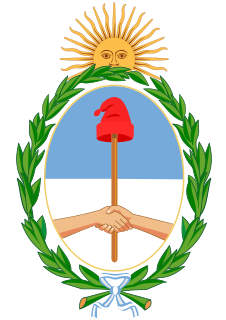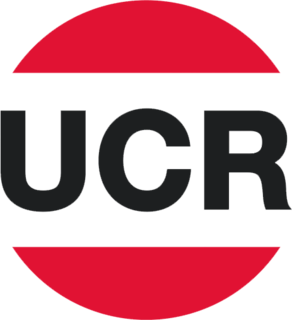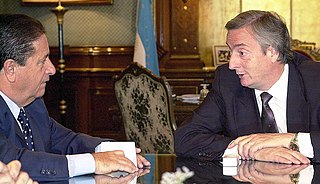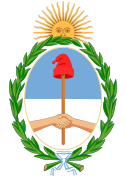 |
|---|
| This article is part of a series on the politics and government of Argentina |
| Foreign relations |
This article includes a list of references, related reading or external links, but its sources remain unclear because it lacks inline citations .(January 2013) (Learn how and when to remove this template message) |
Argentina held national parliamentary elections on Sunday, 23 October 2005. For the purpose of these elections, each of the 23 provinces and the Autonomous City of Buenos Aires are considered electoral districts.

Argentina, officially named the Argentine Republic, is a country located mostly in the southern half of South America. Sharing the bulk of the Southern Cone with Chile to the west, the country is also bordered by Bolivia and Paraguay to the north, Brazil to the northeast, Uruguay and the South Atlantic Ocean to the east, and the Drake Passage to the south. With a mainland area of 2,780,400 km2 (1,073,500 sq mi), Argentina is the eighth-largest country in the world, the fourth largest in the Americas, and the largest Spanish-speaking nation. The sovereign state is subdivided into twenty-three provinces and one autonomous city, Buenos Aires, which is the federal capital of the nation as decided by Congress. The provinces and the capital have their own constitutions, but exist under a federal system. Argentina claims sovereignty over part of Antarctica, the Falkland Islands, and South Georgia and the South Sandwich Islands.

Argentina is subdivided into twenty-three provinces and one autonomous city, Buenos Aires, which is the federal capital of the nation as decided by Congress. The provinces and the capital have their own constitutions, but exist under a federal system.

Buenos Aires is the capital and largest city of Argentina. The city is located on the western shore of the estuary of the Río de la Plata, on the South American continent's southeastern coast. "Buenos Aires" can be translated as "fair winds" or "good airs", but the former was the meaning intended by the founders in the 16th century, by the use of the original name "Real de Nuestra Señora Santa María del Buen Ayre". The Greater Buenos Aires conurbation, which also includes several Buenos Aires Province districts, constitutes the fourth-most populous metropolitan area in the Americas, with a population of around 15.6 million.
Contents
Each district elected a number of members of the Lower House (the Argentine Chamber of Deputies) roughly proportional to their population. Eight districts (Buenos Aires, Formosa, Jujuy, La Rioja, Misiones, San Juan, San Luis, and Santa Cruz) also elected members to the Upper House of Congress (the Argentine Senate); as usual, three senators were elected (two for the majority, one for the first minority).

The Chamber of Deputies is the lower house of the Argentine National Congress. It is made up of 257 national deputies who are elected in multi-member constituencies corresponding with the territories of the 23 provinces of Argentina by party list proportional representation. Elections to the Chamber are held every two years; half of its members are renewed each election.

Buenos Aires is the largest and most populous Argentinian province. It takes the name from the city of Buenos Aires, which used to be part of the province and the provincial capital until it was federalized in 1880. Since then, in spite of bearing the same name, the province does not include the national capital city proper, though it does include all other localities of the Greater Buenos Aires metropolitan area surrounding it. The current capital of the province is the city of La Plata, founded in 1882.

Formosa Province is a province in northeastern Argentina, part of the Gran Chaco Region. Its northeast end touches Asunción, Paraguay, and borders the provinces of Chaco and Salta to its south and west, respectively. The capital is Formosa.
In most provinces, the national elections were conducted in parallel with local ones, whereby a number of municipalities elected legislative officials (concejales) and in some cases also a mayor (or the equivalent executive post). Each provincial election followed local regulations.
In many countries, a mayor is the highest-ranking official in a municipal government such as that of a city or a town.
A number of districts had held primary elections beforehand. In most cases, primary elections are optional and can be called for by the local political parties as needed; in Santa Fe, however, the primaries were universal and compulsory due to a recent law that repealed the much-criticized Ley de Lemas. Turnout continued to decline, and reached 70.9% in these elections.
A primary election is the process by which voters, either the general public or members of a political party, can indicate their preference for a candidate in an upcoming general election or by-election, thus narrowing the field of candidates.
A political party is an organized group of people, often with common views, who come together to contest elections and hold power in the government. The party agrees on some proposed policies and programmes, with a view to promoting the collective good or furthering their supporters' interests.
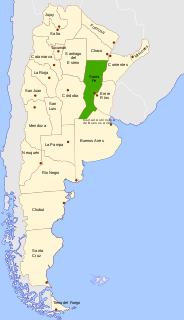
The Province of Santa Fe is a province of Argentina, located in the center-east of the country. Neighboring provinces are from the north clockwise Chaco, Corrientes, Entre Ríos, Buenos Aires, Córdoba, and Santiago del Estero. Together with Córdoba and Entre Ríos, the province is part of the economico-political association known as the Center Region.








